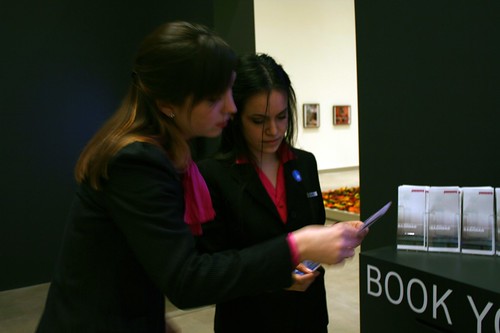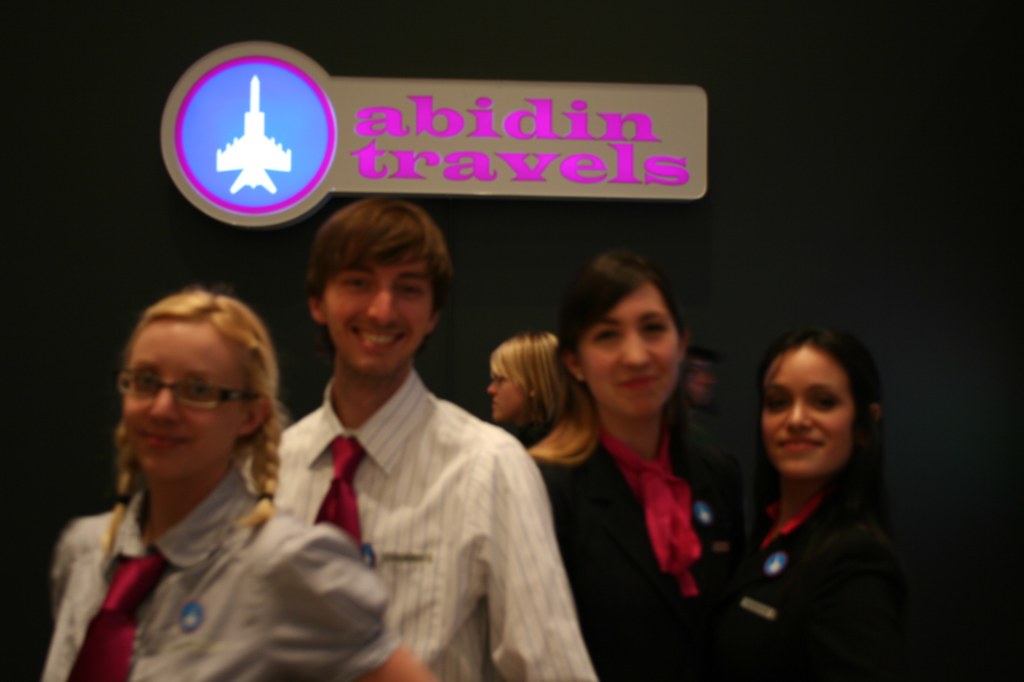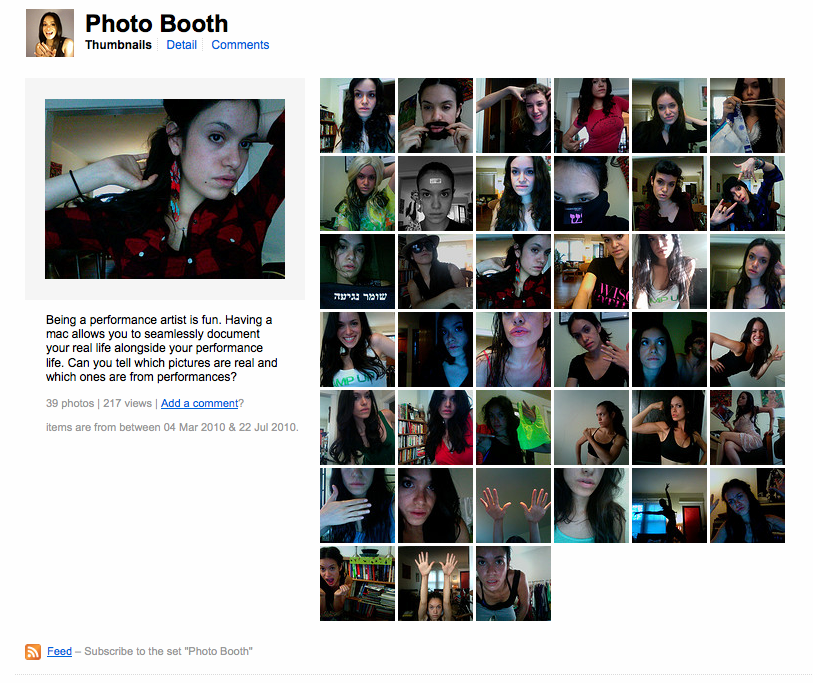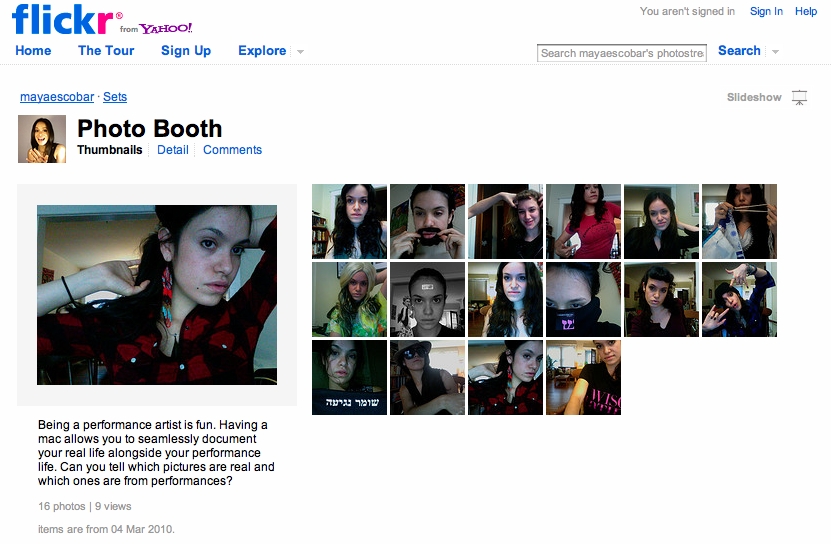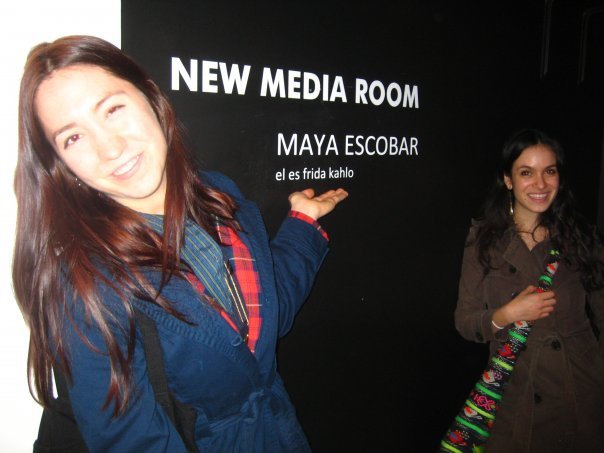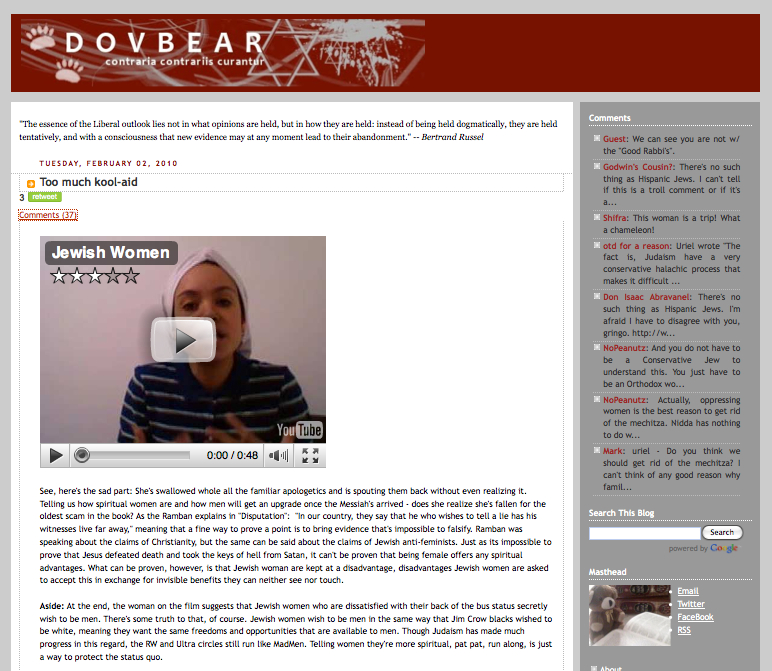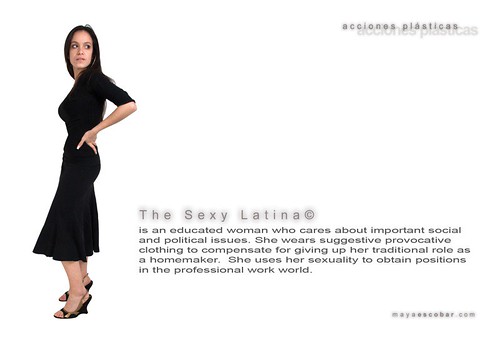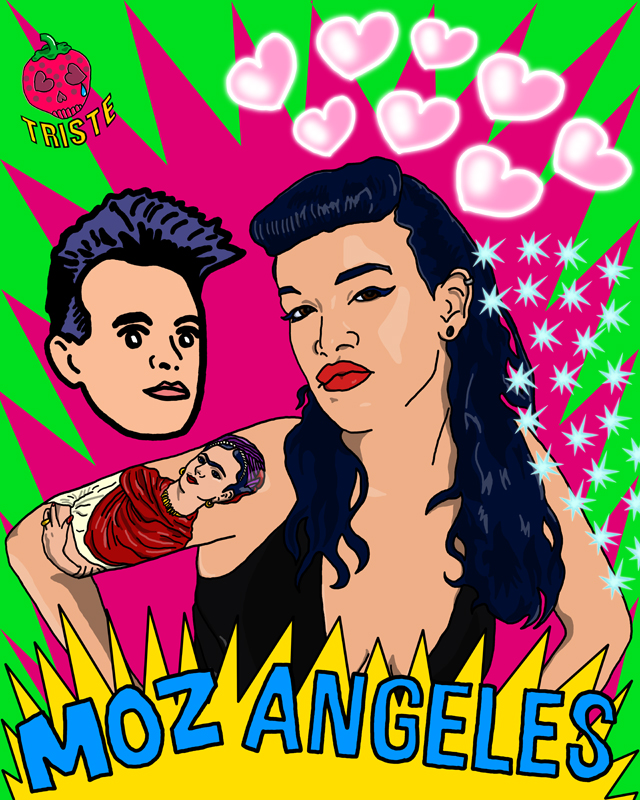ESCOBAR-MORALES: Resurrection of Hun-Nal-Ye at the Bruno David Gallery in St. Louis, MO. Opening on Friday, February 1, 2013, from 5 to 9 pm. Show runs until February 23rd, 2013.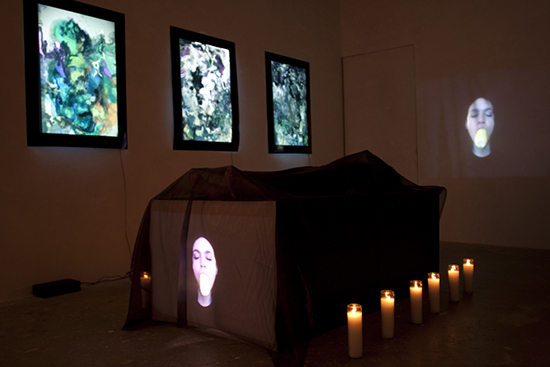 In the New Media Room, the Bruno David Gallery presents a single-channel video work titled “Resurrection of Hun-Nal-Ye” by Escobar-Morales. The 21-minutes video originated from a performance at the closing for RICH-OO-UH'L, RICH-OO-UH'L at Jolie Laide Gallery in Philadelphia, with sound by Armando Morales.In the Resurrection of Hun-Nal-Ye (2011), Escobar-Morales perform a funerary ritual, referencing the mythical Mayan tale of the Hero Twins reviving their dead father, the Maize God. In their contemporary interpretation of this ancient story, Escobar-Morales simultaneously represent the body and the soul; the God/ Goddess and twin offspring, in both physical and technological forms using live performance and web based video projection.ESCOBAR-MORALES is a team comprised of Maya Escobar and Andria Morales. The two artists, based in Chicago and New York respectively, have been working together over the Internet since 2010. They produce digital media and performance art that explores the role of self-representation in visual culture and its ability to deconstruct ingrained ideological conventions. By locating their performances online where they are free from restrictions of time and place, Escobar-Morales is able to concurrently enact multiple personas while simultaneously creating a unified hybrid self.Maya Escobar was born in Chicago, IL in 1984. Andria Morales was born in 1982 in New York, NY. Escobar received a BFA from the School of the Art Institute of Chicago (2007) and an MFA from Washington University in St. Louis (2009); Morales received a BA from the University of Pennsylvania (2004) and an MFA from Tyler School of Art, Temple University (2008).Photo by Armando Morales
In the New Media Room, the Bruno David Gallery presents a single-channel video work titled “Resurrection of Hun-Nal-Ye” by Escobar-Morales. The 21-minutes video originated from a performance at the closing for RICH-OO-UH'L, RICH-OO-UH'L at Jolie Laide Gallery in Philadelphia, with sound by Armando Morales.In the Resurrection of Hun-Nal-Ye (2011), Escobar-Morales perform a funerary ritual, referencing the mythical Mayan tale of the Hero Twins reviving their dead father, the Maize God. In their contemporary interpretation of this ancient story, Escobar-Morales simultaneously represent the body and the soul; the God/ Goddess and twin offspring, in both physical and technological forms using live performance and web based video projection.ESCOBAR-MORALES is a team comprised of Maya Escobar and Andria Morales. The two artists, based in Chicago and New York respectively, have been working together over the Internet since 2010. They produce digital media and performance art that explores the role of self-representation in visual culture and its ability to deconstruct ingrained ideological conventions. By locating their performances online where they are free from restrictions of time and place, Escobar-Morales is able to concurrently enact multiple personas while simultaneously creating a unified hybrid self.Maya Escobar was born in Chicago, IL in 1984. Andria Morales was born in 1982 in New York, NY. Escobar received a BFA from the School of the Art Institute of Chicago (2007) and an MFA from Washington University in St. Louis (2009); Morales received a BA from the University of Pennsylvania (2004) and an MFA from Tyler School of Art, Temple University (2008).Photo by Armando Morales
Calavera Elotera at SOMArts Gallery
ESCOBAR-MORALES PRESENTS: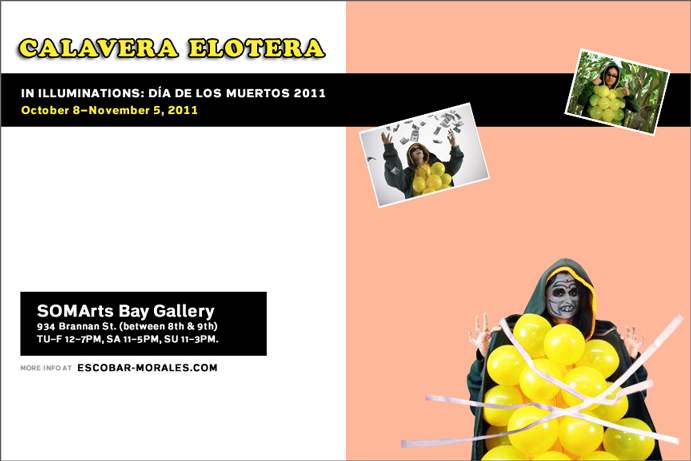 Your favorite fame whore Elotita aka The Fat Free Elotera is back... and this time she has taken it to a new level... she has faked her own death... and has returned as CALAVERA ELOTERA.Calavera Elotera in Illuminations: Día de los Muertos 2011Curated by Rene and Rio Yañez SOMArts Bay Gallery, 934 Brannan St. (between 8th & 9th)San Francisco, CA 94103Tues–Fri, 12–7PM, Sat 11–5PM, Sun 11–3PM.Opening ReceptionFriday, October 7, 2011, 6–9PMOpening will feature music, interactive performance and the unveiling of over 30 altars and installations. The evening includes a special performance by Herbert Siguenza, of Culture Clash fame. Siguenza will perform and live paint as renowned artist, Pablo Picasso.The exhibition continues to examine the ways technology shapes the celebration of Day of the Dead. Once again, a Flickr group enables the exhibition’s curators to accept digital photos as offerings to those who people want to honor. The public can upload their digital contributions here. Selected images will be printed and displayed as part of the exhibit.
Your favorite fame whore Elotita aka The Fat Free Elotera is back... and this time she has taken it to a new level... she has faked her own death... and has returned as CALAVERA ELOTERA.Calavera Elotera in Illuminations: Día de los Muertos 2011Curated by Rene and Rio Yañez SOMArts Bay Gallery, 934 Brannan St. (between 8th & 9th)San Francisco, CA 94103Tues–Fri, 12–7PM, Sat 11–5PM, Sun 11–3PM.Opening ReceptionFriday, October 7, 2011, 6–9PMOpening will feature music, interactive performance and the unveiling of over 30 altars and installations. The evening includes a special performance by Herbert Siguenza, of Culture Clash fame. Siguenza will perform and live paint as renowned artist, Pablo Picasso.The exhibition continues to examine the ways technology shapes the celebration of Day of the Dead. Once again, a Flickr group enables the exhibition’s curators to accept digital photos as offerings to those who people want to honor. The public can upload their digital contributions here. Selected images will be printed and displayed as part of the exhibit.
AMerican MEdia Output in New Jersey
You saw Escobar-Morales as promo models in TX, "promoting" Arizona Tourism... And here we are as marketing executives in NJ.
And here we are as marketing executives in NJ.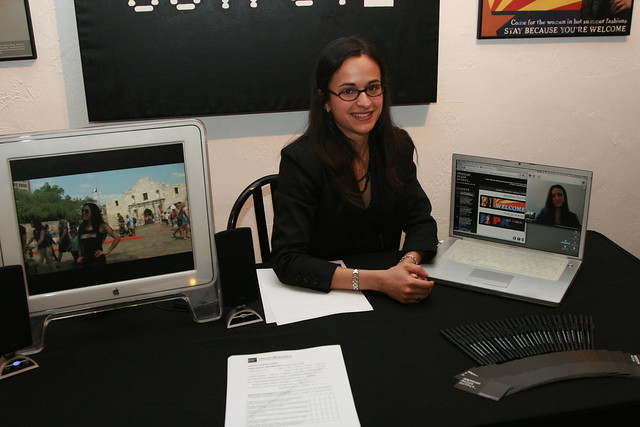 Andria was live at Gallery Aferro and I skyped in from Chicago.
Andria was live at Gallery Aferro and I skyped in from Chicago.

 Stay tuned for more details on the performance and the results from AMerican MEdia Output's #targetaudiencesurvey.
Stay tuned for more details on the performance and the results from AMerican MEdia Output's #targetaudiencesurvey.
AMerican MEdia Output in Texas
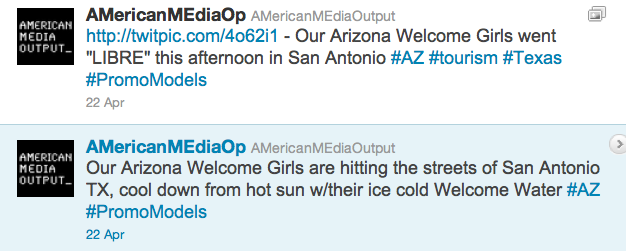 [youtube=http://youtu.be/CMDhowuCwDE]AMericanMEdiaOutput.com
[youtube=http://youtu.be/CMDhowuCwDE]AMericanMEdiaOutput.com![]()
![]()
![]()
Going Public.
 The latest from AMerican MEdia Output's Public Airways Campaign.AMerican MEdia Output is an online marketing and brand design agency with a focus on AMerican travel and tourism. AMerican MEdia Output specializes in creative consulting, web design and development, promotional image and video campaigns, and social media integration and instruction.BEHIND EVERY IMAGE IS A MESSAGE.
The latest from AMerican MEdia Output's Public Airways Campaign.AMerican MEdia Output is an online marketing and brand design agency with a focus on AMerican travel and tourism. AMerican MEdia Output specializes in creative consulting, web design and development, promotional image and video campaigns, and social media integration and instruction.BEHIND EVERY IMAGE IS A MESSAGE.
YouTube Video Reel
AM and I are applying to another residency!Unlike our current Wonder Woman Residency, where we applied as Escobar-Morales, this particular program does not accept joint proposals. So we are submitting seperately and hoping (and hoping and hoping) we will both be accepted.I am applying to the #InternetArt section.[youtube=http://www.youtube.com/watch?v=bk54gsndAQY]And she is applying to the Photo section.
Gallery of Gifs pt 2
If you enjoyed Gallery of Gifs (pt 1) check out these bad boys:(click images to view posts on Are You My Other?)



Ultimate Promo Model for Jewish Identity
have you been kiruv'd lately?
Photo Booth Pt 2
Photo Booth
el es frida kahlo at the gallery
el es frida kahlo is currently on view in the New Media Room at the Bruno David Gallery in St. Louis, MO.
el es frida kahlo, 2007-present
Frida Kahlo played with the identity that she wanted to project and the identity that was placed on her by others. Kahlo used her clothing, political affiliations, sexual escapades, and personal traumas, to create a character that informed her body of work. She inscribed her identity, painting her image over and over, constructing a mythology around her persona.
In el es frida kahlo I confront the ambivalence I experience as a result of my simultaneous obsession with Frida Kahlo and weariness towards her commodification. Viewed from a tiny pinhole, dressed as Kahlo, I stand before a reproduction of one of her self portraits. With a mixture of rage, anxiety, and complete fear, I chant “el es Frida Kahlo, ella es Frida Kahlo, el es Frida Kahlo, yo soy, yo soy, yo soy Frida Kahlo,” he is Frida Kahlo, she is Frida Kahlo, I am, I am, I am Frida Kahlo. As I yell, the painting behind me begins to fall. I violently tear down my braids and smudge off my makeup while continuing to scream “I am Frida Kahlo, I am Frida Kahlo, yo soy Frida Kahlo!”
[youtube=http://www.youtube.com/watch?v=0BJmaYn5IIE]
el es frida kahlo at the Bruno David Gallery (video filmed and edited by Felicia Chen)
[youtube=http://www.youtube.com/watch?v=xlMPoFXRT18]
el es frida kahlo YouTube video
FREE el es frida kahlo animated gif avaliable on MayaEscobar.com
link to translation of recent review by David Sperber in Ma’arav Israeli Arts and Culture Magazine:
Frida Kahlo at the synagogue: Maya Escobar and the young Jewish-American Creation
Jewish Women on DovBear
Last night @DovBear sent me this tweet:
@Mayaescobar posted your jewish women clip w\o realizing it was parody. A little too well done. ;)
I visited his blog and found a post on Jewish Women called Too much kool-aid. The comments generated by this post are really interesting and address the video from a multitude of perspectives.expert from his post:
"Aside: At the end, the woman on the film suggests that Jewish women who are dissatisfied with their back of the bus status secretly wish to be men. There's some truth to that, of course. Jewish women wish to be men in the same way that Jim Crow blacks wished to be white, meaning they want the same freedoms and opportunities that are available to men. Though Judaism has made much progress in this regard, the RW and Ultra circles still run like MadMen. Telling women they're more spiritual, pat pat, run along, is just a way to protect the status quo."
[youtube=http://www.youtube.com/watch?v=8H8mpau6dSc]
Jewish Women from the series Acciones Plásticas 2007
click here to see FULL POST and COMMENTS
selection comments posted below:
 zapp645if you follow the link-trail, it becomes clear that this video is likely making fun of the attitudes it depicts. so as right as what you say in this post is, it's not really aimed at this video...
zapp645if you follow the link-trail, it becomes clear that this video is likely making fun of the attitudes it depicts. so as right as what you say in this post is, it's not really aimed at this video... urielSo are you opposed to any distinction whatsoever between men and women in Judaism? Do you think we should get rid of the mechitza and the laws of niddah and negiah and tzniut because they all make distinctions between male/female and thus somehow discriminate against and oppress women? If so, why aren't you a Conservative Jew? If not, why not? What kinds of distinctions between men and women are not discriminatory in your book?The fact is, Judaism have a very conservative halachic process that makes it difficult or impossible to change most things. Do you think we should change that process to make it easier to make big changes? If so how is that different from the Conservatives?People mistakenly think that every explanation for distinctions between men and women must be some kind of conspiratorial justification for the status quo. But that's not true. You have to look at the history of the explanation. For example, consider shelo asani isha. The explanation is, women, slaves and gentiles don't have to perform certain mitzvot, so we're thanking Hashem for giving us more mitzvot to do. Conspiracy to trick people into thinking Judaism isn't sexist? No -- it's in the tosefta to the earlier version of the three berachot (which thanked Hashem for not making one an ignoramus.) So that supposedly "P.C." explanation was from before the mitzvah was even finalized!It's a mistake to think about Judaism in the same terms you think about American history. It's apples and oranges. If not, you'd be calling someone a "bigot" for not accepting the ordination of women, just like many liberals today will call you a bigot if you don't accept gay marriage. Of course bigot is an implicit reference to anti-black American racism. Which is a lot different from differing roles of the sexes in Judaism.
urielSo are you opposed to any distinction whatsoever between men and women in Judaism? Do you think we should get rid of the mechitza and the laws of niddah and negiah and tzniut because they all make distinctions between male/female and thus somehow discriminate against and oppress women? If so, why aren't you a Conservative Jew? If not, why not? What kinds of distinctions between men and women are not discriminatory in your book?The fact is, Judaism have a very conservative halachic process that makes it difficult or impossible to change most things. Do you think we should change that process to make it easier to make big changes? If so how is that different from the Conservatives?People mistakenly think that every explanation for distinctions between men and women must be some kind of conspiratorial justification for the status quo. But that's not true. You have to look at the history of the explanation. For example, consider shelo asani isha. The explanation is, women, slaves and gentiles don't have to perform certain mitzvot, so we're thanking Hashem for giving us more mitzvot to do. Conspiracy to trick people into thinking Judaism isn't sexist? No -- it's in the tosefta to the earlier version of the three berachot (which thanked Hashem for not making one an ignoramus.) So that supposedly "P.C." explanation was from before the mitzvah was even finalized!It's a mistake to think about Judaism in the same terms you think about American history. It's apples and oranges. If not, you'd be calling someone a "bigot" for not accepting the ordination of women, just like many liberals today will call you a bigot if you don't accept gay marriage. Of course bigot is an implicit reference to anti-black American racism. Which is a lot different from differing roles of the sexes in Judaism. NoPeanutzActually, oppressing women is the best reason to get rid of the mechitza. Nidda has nothing to do with this.And Tzniut has nothing to do with this. Tzniut has everything to do with social norms. Oppressive double-standard tzniut should be abolished immediately,
NoPeanutzActually, oppressing women is the best reason to get rid of the mechitza. Nidda has nothing to do with this.And Tzniut has nothing to do with this. Tzniut has everything to do with social norms. Oppressive double-standard tzniut should be abolished immediately, NoPeanutzAnd you do not have to be a Conservative Jew to understand this. You just have to be an Orthodox woman.
NoPeanutzAnd you do not have to be a Conservative Jew to understand this. You just have to be an Orthodox woman. AnonymousAFIK the mechitza is an outcropping of the orthodox halachic process. It is at least a universally (amongst orthodox) practice minhag. How would abolishing the mechitza be consistent with orthodox Judaism?I enjoy davening in my own (men's) section, because I would likely feel distracted/embarrassed by any attractive women in our shul standing next to me, hearing me sing, etc. I don't see how this translates into a desire on my part to oppress women. I'm sure there are men who wouldn't feel this way, and would probably daven just fine, just as there are young men, on the other side of the spectrum, who would maybe even ogle women. But it's impossible to satisfy everyone in a community.I agree that there are misogynists in Jewish communities, but I don't think allocating separate space to men and women in the synagogue automatically translates into oppressing women.
AnonymousAFIK the mechitza is an outcropping of the orthodox halachic process. It is at least a universally (amongst orthodox) practice minhag. How would abolishing the mechitza be consistent with orthodox Judaism?I enjoy davening in my own (men's) section, because I would likely feel distracted/embarrassed by any attractive women in our shul standing next to me, hearing me sing, etc. I don't see how this translates into a desire on my part to oppress women. I'm sure there are men who wouldn't feel this way, and would probably daven just fine, just as there are young men, on the other side of the spectrum, who would maybe even ogle women. But it's impossible to satisfy everyone in a community.I agree that there are misogynists in Jewish communities, but I don't think allocating separate space to men and women in the synagogue automatically translates into oppressing women. NoPeanutzIn most Orthodox shuls, I would agree that most mechitzot themselves are misogynistic.Buried in the back, or the corner, with an obstructed view of the proceedings.The purpose of the mechitza is to allow for the inclusion of women in the service. Not the exclusion.
NoPeanutzIn most Orthodox shuls, I would agree that most mechitzot themselves are misogynistic.Buried in the back, or the corner, with an obstructed view of the proceedings.The purpose of the mechitza is to allow for the inclusion of women in the service. Not the exclusion. urielThis wikipedia article seems to support your views, except for the citation of R' Hirsh (who might be hard to depict as a feminist). But the article may be leaving out earlier sources.http://en.wikipedia.org/wiki/Role_of_women_in_Judaism#Debates_within_Orthodoxy
urielThis wikipedia article seems to support your views, except for the citation of R' Hirsh (who might be hard to depict as a feminist). But the article may be leaving out earlier sources.http://en.wikipedia.org/wiki/Role_of_women_in_Judaism#Debates_within_Orthodoxy RubyVIt's part of a series called Acciones Plasticas by a Jewish Latina artist. http://mayaescobar.com/accionesplasticas.html It looks like an examination/satire of the stereotypes associated with her heritage.
RubyVIt's part of a series called Acciones Plasticas by a Jewish Latina artist. http://mayaescobar.com/accionesplasticas.html It looks like an examination/satire of the stereotypes associated with her heritage. E. FinkTITCR
E. FinkTITCR Sh'lomo'Whoah, that lady had the most steriotypical modeof Ashkenazi-Jewish speech I ever saw...
Sh'lomo'Whoah, that lady had the most steriotypical modeof Ashkenazi-Jewish speech I ever saw... DovBearUriel do you really and truly think everything frum Jews say and do is authentically Jewish? well guess again. The post is a critism of the man made culture, not the god decreed religion.
DovBearUriel do you really and truly think everything frum Jews say and do is authentically Jewish? well guess again. The post is a critism of the man made culture, not the god decreed religion. urielThe answer to your question is no. Will you answer my questions?
urielThe answer to your question is no. Will you answer my questions? urielLook at the quote from Rav Hirsh in the wikipedia article and you'll see that the idea that women are more spiritual than men is indeed authenticly Jewish (unless you see Rav Hirsch as some kind of pre-feminist apoogist). How old it is, I'm not so sure.
urielLook at the quote from Rav Hirsh in the wikipedia article and you'll see that the idea that women are more spiritual than men is indeed authenticly Jewish (unless you see Rav Hirsch as some kind of pre-feminist apoogist). How old it is, I'm not so sure. DovBearThe idea that women have a better nature or more spiritual is NOT authenticly Jewish. We know this because non Jews got fed the same horse manure as a way of keeping them satisfied with less. Look, I dont even know what youre arguing: The more right you go the worse off Jewish women are -in satmar they cant even drive and have to shave their heads. Thats an inrefutable facr.
DovBearThe idea that women have a better nature or more spiritual is NOT authenticly Jewish. We know this because non Jews got fed the same horse manure as a way of keeping them satisfied with less. Look, I dont even know what youre arguing: The more right you go the worse off Jewish women are -in satmar they cant even drive and have to shave their heads. Thats an inrefutable facr. urielThat's an odd way of proving something, you have to admit. I think a better way is to see how old an idea is. But even if it's not that old, if Rav Hirsh and Rav Aaron Soloveichik said it, I would say that's pretty authentic. Something doesn't have to be somewhere in the Mishnah to be authentic (though the older the more authentic). Much of kabbalah, mussar and chassidus would be inauthentic if that were your standard. At that point you'd be creating your own special denomination that is very picky and choosy about what in modern Judaism is authentic to you -- and that sounds like Reform.
urielThat's an odd way of proving something, you have to admit. I think a better way is to see how old an idea is. But even if it's not that old, if Rav Hirsh and Rav Aaron Soloveichik said it, I would say that's pretty authentic. Something doesn't have to be somewhere in the Mishnah to be authentic (though the older the more authentic). Much of kabbalah, mussar and chassidus would be inauthentic if that were your standard. At that point you'd be creating your own special denomination that is very picky and choosy about what in modern Judaism is authentic to you -- and that sounds like Reform. urielAre you saying Satmar is more authentic than other Jewish groups? Chazal surely had more contact with heretics and gentiles than Satmar does.
urielAre you saying Satmar is more authentic than other Jewish groups? Chazal surely had more contact with heretics and gentiles than Satmar does. E. FinkI think Zapp is right.
E. FinkI think Zapp is right.
This is a parody / satire for sure. She is NOT serious.
Also check out comments generated by a 2007 post by DovBear on Shomer Negiah Panties called Tzittzit for women?.
Latina Women Respond
Recently Latina Role Model was featured on TikiTiki Blog: stories with cultura, color and sabor, in a post by Carrie Ferguson Weir called Smart Latina vs. Sexy Latina. Carrie asked readers:
So, has your Smart Latina run up against the Sexy Latina? What do you see when you watch Maya’s video? What does it bring up for you? Why can’t we be both Smart and Sexy? Let’s talk about this, break it down, maybe shatter some stereotypes, and bust our own too.
Check out the PROFOUND difference in the nature of the comments left on this post (comments posted below) vs the ones left on YouTube.[youtube=http://www.youtube.com/watch?v=F_1X1igrL4U]my contribution to post on Tiki Tiki:
I perform over-the-top representations of different identities. I group together these representations (characters) as a means of challenging limited perspectives of what women are like, and in this case, what Latina women are like.
This character is supposed to be an intellectual, accomplished, socially conscious woman- who will forever be seen as the “Sexy Latina.” The low quality video blog is meant to mock scenes in movies, where the hot high school teacher walks down the hall and all the boys undress her in their minds.
But I am not taking a negative or positive stance either. I want to question the role Latinas play in perpetuating this persona, and question if that is even a bad thing? Are we limiting ourselves by continuing to have this same conversation, even though the behavior persists, are we enforcing it by bring more attention to it?
I haven't always been so impartial. Out of all of the characters in Acciones Plásticas, The Latina Role Model is the one I identified with the most. My original description of the way this character was perceived by others was much more reactionary and much angrier than it is now. (see below)
The Sexy Latina© from Acciones Plásticas free (stereotype) postcard, 2007
The Sexy Latina© is an educated woman who cares about important social and political issues. She wears suggestive provocative clothing to compensate for giving up her role as a homemaker. She uses her sexuality to obtain positions in the work world.
 Latina Role Model from Acciones Plásticas プリクラ 2009
Latina Role Model from Acciones Plásticas プリクラ 2009
Over the last two years this character has really evolved. Here is the new description of The Latina Role Model, re-imagined as part of my Acciones Plásticas プリクラ collaboration with artist Rio Yañez:
The Latina Role Model is a diploma totin’ intellectual, sexy, social media goddess.
What do you think? How does the earlier description of The Sexy Latina© differ from this new description of The Latina Role Model? How do these two images relate to the Latina Role Model YouTube video?
-
Sra. López says:
This is an excellent post and an excellent video. It really does make you think.I am really not qualified to speak from a “Latina perspective” on this topic because I am Anglo. (If you read my blog, you’ll know I’m Sra. López only because I married a Salvadoran.)That being the case, I can’t speak from personal experience on Latina stereotypes, but I would like to contribute an opinion or two on topics that are pretty closely related.For example, it really bothers me that the Latinas picked as reporters and journalists on Univision and Telemundo seem to be more for the purposes of eye candy than to report the news and add intelligent commentary — not that they aren’t intelligent women, but I think the sexism by the head honchos over there is pretty evident, not just on the news, but on other programming as well… And English language channels aren’t always much better. I think Western women in general – no matter what their race, fight very hard to overcome the sense that we are valued more as objects of sex/beauty, than for what’s inside.It’s very frustrating and I don’t envy the difficult job many women have of raising daughters in this world. (I have 2 sons) … With my own self esteem issues, I can’t imagine what a challenge it would be to raise a girl who is confident in herself and who doesn’t let Hollywood, fashion magazines, men, or even other females, get her down.I don’t know the solution to achieving true equality, but I think talking about it all is a good start.
-
Angelica Perez says:
Very interesting…The role model I immediately identified with was the socially-conscious, smart role model, which made me realize how loaded that role is. Being an accomplished and educated Latina comes with so many expectations — the whole giving back to the community, serving your community, being a role model and mentor for others, etc. — that’s not something that an accomplished non-Latina woman has to worry about (or feel committed to).With regards to the sexy role model — I always say that there is no sexier woman than the one that exudes confidence in herself and who she is — the sexy clothes are just extras…Great conversation…
-
[...] Tiki Tiki: Stories with Cultura, Color and Sabor, thanks to post by Carrie Ferguson Weir entitled Smart Latina vs Sexy Latina. Check out the post and be sure to leave your [...]
-
Ana Lilian says:
I guess I just never even thought of myself as the Sexy Latina…but a cute one yes! LOL! But once I´m on the dance floor, then the sexy comes out and it´s all good.But,seriously, I guess I just lack the perceived-Latina sassy-ness as I´ve never felt that bias towards me.I will definitely agree with dear Sra. López that the media, especially the Hispanic media, is completely promoting the hot Latina stereotype, and not much of the smart Latina one. Why do their “news” anchors feel they need to have their breast augmented to be taken seriously?
-
Kikita says:
I think it is inherent in our culture to be “hot” in every sense of the word because we are so passionate.I love what Maya was trying to accomplish and say with her video, but I found that she couldn’t hide or deny her Latin sensuality even when she was trying to play the part of an “intellectual, accomplished, socially conscious woman.”This DID make me stop and think, but what I realized is that I tend to shoot for a 3rd type. I go for “Classy Latina.” You know, the one that can wear the big hoops and sexy top with a pant suit. Someone like Ingrid Hoffman or Karla Martinez.
-
C. Morales says:
My impression is that Latina women play into the stereotype because Latino men often expect them to, and they are threatened by a smart woman. It is not just non-Latino men who expect a mujer caliente and nothing more.
-
Liz says:
How you project yourself, depends on you, no matter what. I, like Ana, never felt that I was looked at differently because I am Latina. I don’t see my self as a Sexy, Hot, Latina(I hope my husband does, though). Hell, I’m 33, been married for 12 years, and have 3 kids. I don’t get “chifles” anymore… ): LOL!This is directed towards the younger, single generation. How they present themselves as the future “Latina Generation”, depends on how they are raised. It’s up to us, as moms, to teach our daughters to go and be the BEST they can be. It’s up to me to raise my daughter to know what it right from wrong. Do guys really still think that girls are still destined to be “home/baby makers? Really??Forget Hollywood. Forget the Media. Heck, forget the evening news. If those ladies felt that they need to have their lady lumps hanging out in order to get the job, then I feel sorry for them. But, it is what it is.I will raise my daughter to know that education is the key to being classy and sexy! Not exposed Humps and Lady Lumps! Also, I will raise my boys to see women and they see themselves. Whether they marry a Latina or not.Ay, me pase de mas! he he!
-
SUZ says:
A smart and fun video commentary on the stereotypes of women in general…the educated intellectual, the hot babe, the innocent women. I like that Maya uses humor to deflect the extremes. Also that she creates a fine line between integrating the different role types. This is interesting because everyone is never just one thing…but we may choose to identify one way.
-
Melissa Garcia Logan says:
I think it’s part of a male dominated culture. Many women have this problem of having to manage male expectations in their professional lives, whether it is living with objectification or men projecting their need for nurturing from any woman they meet. I’ve had jobs where men thought it was okay to flirt with me and expected me to fulfill some messed up hot secretary fantasy, and I’ve had jobs where men I worked with expected me to be maternal and when I was driven, I was labeled aggressive. I’m not a dog, I’m not a hooker, and I’m definitely not your mother, guys.I think we have to teach men when they’re children that women can fill many roles and to expect them to be as capable and androgynous as any man performing the same duties. By the same token, I don’t know how I feel about using gender or sexuality as an asset to get ahead, my feeling is that anything you do that is manipulative in nature, is skirting unethical, if not flat out crossing the line.Having a sense of humor about stereotypes though, I don’t know if I see a problem as long as you don’t go too far and reinforce them. If it’s clear it’s a joke and part of the joke is how ridiculous stereotypical behavior really is…
-
 Carrie says:
Carrie says:I love the feedback, ladies. All great points and fabulous reflection.I am left wondering this, after reading Ana and Liz’s comments: Is stereotype/perception felt/seen at a greater level when we don’t live in predominately Latino communities?This comes to mind because your comments made me realize I never thought too much of my Latina side and my American side until I lived in cities where there weren’t a bunch of Cubans running around me everywhere. My otherness was apparent and pointed out. It was almost like, wow, I am different?Interesting!
-
Marta says:
I don’t fit into the Sexy or Brainy Latina mold at all. Probably because I look very Anglo – light skin, blue eyes. I blend pretty seamlessly into my So Cal suburban life.Except for the Latina “chispa.” That’s always the big giveaway right there. =D
-
Liz says:
Carrie,I emailed your post to my niece, whose studying at Penn State, this is what she had to say:Well, I agree with her lol. A lot of people especially here in Pennsylvania, see me as exotic because I’m Hispanic. They expect me to speak Spanish all of the time and a lot of them expect me to be kinda stupid and slutty. But when people get to know me, they find out that I’m extremely smart. Smarter than most people they encounter. And it sucks because I’m always having to prove myself to people and to teachers. But in the end, I’m the one that’s dropping jaws for my intellect and not for my attractiveness =)The end haha. Hope that helps.I am one PROUD Tia!!! (:
-
 Carrie says:
Carrie says:Liz, aha! Thank you for sending the post to your niece and validating my theory. I love how your niece wrote to you and the “stupid and slutty” line made me bust out laughing — especially because she obviously is not.Gracias, proud Tia!(Maybe she needs to write for the Tiki Tiki? hmmmm?)
-
Veronica says:
Great video and excellent points.I think that this expectation for Latinas to appear sexy is one reason why I reject the hot mom movement. I wish there was just as much social pressure to be smart Latinas, smart moms, smart women as there is to be hot, sexy, etc.
behind the scenes acciones plásticas purikura
Here are some behind the scenes images from the many Acciones Plásticas プリクラ photo shoots.
The Latina Hipster
The Homegirl
The Homegirl putting on fake nails (lovin' the shabbos candlesticks and theory books in the background)
The Avodah Girl
The 612er
---------------------------------------------------------
Check out this inspiring write-up on Acciones Plásticas プリクラ on Truth and Healing Project.excerpt below:
goodness. I’ve been thinking a lot about the intersections between new media and traditional forms of knowledge and how these intersections can be ways of supporting tradition, innovation, resistance and liberation. As a media-maker, I’ve thought a lot about non-traditional forms of telling stories and the value of stories to allow us as individuals and communities to grow and remain in movement. I want to both honor our traditions and create space for challenge in order to support growth. This is particularly challenging when, as indigenos, we are usually FORCED into the frozen stance (as my sister Whisper says) of the “American Imaginary”. Born out of a flat analysis, the “American Imaginary” boxes us into specific archetypes and narratives that, though perhaps grounded in truth, metaphorically and at times literally “freeze” us and immobilize us from engaging in healthy movement and LIFE. As a guatemalan-born/ mixed -id’d/ mayan-adoptee I’ve dreamed about new and innovative ways to create forums and craft form that embodies the intersections of say, mayan id, transracial queer, working class, single teen mama id. For example, as a queerasfuck femme I’ve LITERALLY dreamed of beginning a series of corsets created out of huipil’s with stories attached to each… though I have yet to begin work on that. I am so excited by the thoughts of spaces for dialogue, beauty, challenge & examination of the COMPLEX identities embodies by the our contemporary indigena communities. . Fierce and phenomenal chicana and radical latina artists have had HUGE impacts on me but I’ve been hungry to see this come from other guatemelan/ mayan artists. Today, I got a taste of a contemporary and GUATEMALAN artist who is actively engaged in a similar examination! I came across this blog (and art work) and it was as if an answer was given to me in the form of possibilities. A sweet affirmation that this form of mayan/guatemalan art CAN and DOES exist.
maya carrying maya
The wonderful Suzan Shutan has agreed to help me with my resume/cv/statements in exchange for web design and video work. I couldn't think of a better collaboration. Here is one of the many projects (and its many iterations) that I am attempting to catalog for said documents...
Tallit Rebozo, from the series Hiddur Mitzvah, Quilted, Embroidered, Woven, and Recycled Fabric, 2006
Comodification Series: Modeling Tallit Rebozo, Performance 2006
Comodification Series: Maya Carrying Maya, Photo Collage, 2006
[youtube=http://www.youtube.com/watch?v=tr8B1u0jw0c]
Gringa Loves Guatemala, YouTube Video, 2007
Maya Carrying Maya, YouTube background, 2009
Maya Carrying Maya, Twitter background, 2009



Former Myspace Profile Picture, found internet photo (repeated here 3 times), 2006
Darja Bajagić
Darja sent me a beautiful email on YouTube earlier this week. Needless to say, I was quite taken by her.
[youtube=http://www.youtube.com/watch?v=SuZtuDZjvQE][youtube=http://www.youtube.com/watch?v=6hY2_e-HWYI][vimeo=http://vimeo.com/3465404][vimeo=http://vimeo.com/3064268]
video reel
[youtube=http://www.youtube.com/watch?v=3li_mT--f-A&hl=en]
ARTE ≠ VIDA: ACTIONS BY ARTISTS OF THE AMERICAS
Last weekend Carianne and I went to NY for the 2008 Whitney Biennial. As we expected from a survey of Contemporary American Art, not everything in the exhibition appealed to us. However neither of us was disappointed because we were not expecting to be unilaterally wowed. Upon leaving the Whitney, we got into an in-depth discussion about individuals' preconceived expectations, and the role they play in the determining interaction/interpretation/enjoyment, with actual works of art. Soon after this conversation, I was put to the test. As any young MFA student (traveling to New York) who has any hopes of some day having a career, Carianne and I were preparing to leave our hotel, to visit the elusive Chelsea Galleries, when I came upon an announcement for a show at El Museo Del Barrio, ARTE ≠ VIDA: ACTIONS BY ARTISTS OF THE AMERICAS
“Arte no es vida” surveys, for the first time ever, the vast array of performative actions created over the last half century by Latino artists in the United States and by artists working in Puerto Rico, the Dominican Republic, Cuba, Mexico, Central and South America.
Many of the works included in Arte ≠ Vida have subtle or overt political contexts and content: military dictatorships, civil wars, disappearances, invasions, brutality, censorship, civil rights struggles, immigration issues, discrimination, and economic woes have troubled the artists’ homelands continuously over the past four decades and therefore have infiltrated their consciousness. According to curator Deborah Cullen, “the exhibition title challenges the commonplace idea that art is equivalent to life, and life is art. What is proposed through these many works is that while art affirms and celebrates life with a regenerative force, and sharpens and provokes our critical senses, artistic actions which address inequalities and conflict are not equivalent to real life endured under actual repression.”
Over 75 artists and collectives are represented in Arte ≠ Vida, including ASCO, Tania Bruguera, CADA, Lygia Clark, Papo Colo, Juan Downey, Rafael Ferrer, Guillermo Gómez-Peña, Alberto Greco, Alfredo Jaar, Tony Labat, Ana Mendieta, Marta Minujin, Raphael Montañez-Ortiz, Hélio Oiticica, Tunga and contemporary practitioners including Francis Alÿs, Coco Fusco, Regina José Galindo, Teresa Margolles and Santiago Sierra. The exhibition is arranged in four major sections, in which each decade is represented by several specific themes that often cross national boundaries. 1960-1970 looks at select precursors, signaling, destructivism and neoconcretismo; 1970-1980 considers political protest, class struggle, happenings, land/body relationships and border crossing; 1980-1990 focuses upon anti-dictatorship protest and dreamscapes; and 1990-2000 references the Quincentenary, multiculturalism, postmodernism and endurance. An additional section highlights interventions that artists have carried out on television over the past 20 years. In these chronological, thematic groupings, viewers will be able to explore the interconnections among various artists’ actions as well as the surges of activities triggered by specific events in certain countries.
I didn't know what to do. This sounded to good to be true, but we also knew we were supposed to visit the Chelsea Galleries. I considered just buying the catalogue to the exhibition and skipping the show. I don't know if it was faith or instinct that got us there, but I can say with out any doubt in my mind that this was single handedly the best exhibition I have ever attended.
"¿Quién puede olvidar las huellas?," Regina Galindo. 2003.
Galindo walking through the streets of downtown Guatemala City, wetting her feet in a blood-filled bucket, and leaving a path of footprints from the Constitutional Court building to the Presidential Palace, where she was welcomed by a police battalion. The Court had just validated former dictator Efraín Ríos Montt, the country’s foremost author of genocide, as a presidential candidate.
[youtube="http://uk.youtube.com/watch?v=D46p71QdCTc"]

Oscar Bony (1941-2002) hired a working-class family at twice their going wage to pose in a Buenos Aires gallery as a living work of art
[youtube=http://uk.youtube.com/watch?v=8N5xbLtokZY]
"Arte Reembolso/Art Rebate" by Elizabeth Sisco, Louis Hock and David Avalos. 1993.


[...] "The current economic recession has been debilitating for many artists regardless of the content of their work. Since this climate is characterized by a particular hostility toward controversial art, it is especially significant that Elizabeth Sisco. Louis Hock. and David Avalos have maintained a reputation for causing trouble in San Diego. Their collaborative public art projects receive scandalous reports in local and national news media and are often used as examples of the National Endowment for the Art' inadequate standards of quality. Their most current collaborative project Art Rebate (1993) refunded $10 bills to 450 undocumented workers along the San Diego, California/Mexico border. It was commissioned by the Museum of Contemporary Art, San Diego and Centro Cultural de la Raza as part of the "La Frontera/The Border" exhibition. In response to recent attention to border relations due to NAFTA and other government policies, the artists wished to refute the popular misconception that undocumented Mexican workers do not pay taxes as well as demonstrate. albeit with a small symbolic gesture, their appreciation of the undocumented as valued members of Western states, communities. Furthermore, I believe their work has significant implications for undocumented workers from other nations, residing in other regions of the United States - Caribbean workers in Florida and New York City, for example. If the communities in which the undocumented workers from these areas work and reside could also acknowledge their common contributions, in the form of taxes among other things, then perhaps we as a society could also begin to address the crimes inflicted upon these groups and apply our democratic notions of human rights to those within our national borders. [...]
"The projects are clearly controversial. That's not an accident. It's not as if someone latches onto the projects and holds them up as problematic. We intend to create something that is provocative and engenders a public discussion. It is public art, not art in the public. The work is defined by its performance in the community. The public discussion is crucial to the project. In order to begin a discussion we initiate an action - for example, a bus poster or a $10 rebate - that starts the ball rolling. We definitely aim to draw in the broadest spectrum of people, including those in power for the discussion. Obviously the media is not a neutral mechanism for communicating the events that unfold during the projects: it has an agenda that shapes its participation in the discussion. For example, much of the language used to describe Art Rebate in the press was the same inflammatory rhetoric promoted and laid out by the politicians who had given a profile of blame to the undocumented. Similarly, the press had a hard time imagining, and therefore was unable to fairly convey, the undocumented as taxpayers. The press was invited to experience the act of rebating these signed $10 bills. They were encouraged to ask the opinion of undocumented workers concerning their status as taxpayers, but the responses failed to appear prominently in the news media. The media coverage was not a means of evaluating the project but rather a component of the project. Their viewpoints describe a conceptual social space in which they situate the taxpayer and the undocumented in different realms."
"The Parthenon of Books/Homage to Democracy, Buenos Aires," Marta Minujín. 1983.
In December 1983 the Argentine Conceptual artist Marta Minujin and a group of helpers spent 17 days building a full-scale model of the Parthenon in a public park in Buenos Aires, Roberta Smith writes. Except for a metal scaffolding, it was made almost entirely of books wrapped in plastic. All the books had been banned by one of the most oppressive juntas in the country’s history, which was just being dismantled after Argentina’s first democratic election in a decade. “The Parthenon of Books/Homage to Democracy,” as Ms. Minujin’s work was titled, stood for about three weeks. Then the public was allowed to disassemble the piece and keep the books.
partenon de libros marta minujinAvenida 9 deJulio y Avenida Santa Fe. Buenos Aires. Argentina. Concebida como un monumento a la democracia y a la educación por el arte, Partenón constaba una estructura metálica, réplica del partenón, recubierta con prohibidos durante la dictadura militar.


[...]In a similar fashion to the live human spectacles of the past, Fusco and Gomez-Peña performed the role of cultural "other" for their museum audiences. While on display the artists' "traditional" daily rituals ranged from sewing voodoo dolls, to lifting weights to watching television to working on laptop computers. During feeding time museum guards passed bananas to the artists and when the couple needed to use the bathroom they were escorted from their cage on leashes. For a small donation, Fusco could be persuaded to dance (to rap music) or both performers would pose for Polaroids. Signs assured the visitors that the Guatinauis "were a jovial and playful race, with a genuine affection for the debris of Western industrialized popular culture . . . Both of the Guatinauis are quite affectionate in the cage, seemingly uninhibited in their physical and sexual habits despite the presence of an audience." Two museum guards from local institutions stood by the cage and supplied the inquisitive visitor with additional (equally fictitious) information about the couple. An encyclopedic-looking map of the Gulf of Mexico, for instance, showed the supposed geographic location of their island. Using maps, guides, and the ambiguous museum jargon, Fusco and Gomez-Peña employed the common vocabulary of the museum world to stage their own display[...]
"Construction of a Traditional Rural Oven,'' Víctor Grippo y Jorge Gamarra. 1972.
CONSTRUCCION DE UN HORNO POPULAR PARA HACER PAN
Intención: Trasladar un objeto conocido en un determinado entorno y por determinada gente, a otro entorno transitado por otro tipo de personas.Objeto: Revalorizar un elemento de uso cotidiano, lo que implica, además del aspecto constructivo escultórico, una actitud.Acción:a) Construcción del Hornob) Fabricación del Panc) Partición del Pan.Resultante pedagógica: Describir el proceso de construcción del Horno y de la fabricación del Pan. Distribuir una hoja. Será posible la participación del público mediante un intercambio de información.
"Untitled (Body Tracks),'' Ana Mendieta. 1974.

The Cuentos Foundation
I just submitted the work of Michele Feder-Nadoff, to the magazine I work for Zeek. Michele is a dear friend and a phenomenal artist, activist and educator. I thought it would be a good idea to share some information about Michele and to promote her organization the cuentos foundation.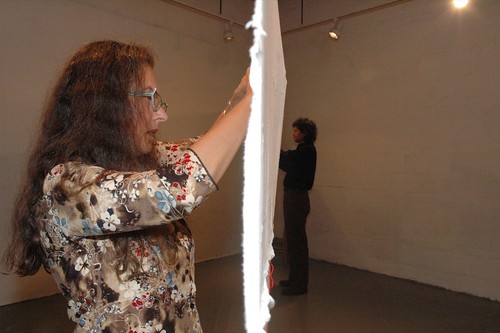 Artistic Director, Michele Feder-Nadoff, who is Jewish, founded Cuentos in 1998 with the humanist vision and commitment to tikkun haolam, a Jewish principal expressing each person’s responsibility to play a part in "healing the world." Cuentos members believe art is a transformative catalyst for effecting positive social change. Our work combats prejudice and discrimination through artistic and educational intergenerational projects and programs promoting mutual understanding.The abundance of cultural wealth living doorstep to doorstep in our neighborhoods provide all of us an opportunity to engage with and learn about each others' backgrounds. What connects us and how can live in peace together, connected by mutual understanding and appreciation of different cultures from around the globe?
Artistic Director, Michele Feder-Nadoff, who is Jewish, founded Cuentos in 1998 with the humanist vision and commitment to tikkun haolam, a Jewish principal expressing each person’s responsibility to play a part in "healing the world." Cuentos members believe art is a transformative catalyst for effecting positive social change. Our work combats prejudice and discrimination through artistic and educational intergenerational projects and programs promoting mutual understanding.The abundance of cultural wealth living doorstep to doorstep in our neighborhoods provide all of us an opportunity to engage with and learn about each others' backgrounds. What connects us and how can live in peace together, connected by mutual understanding and appreciation of different cultures from around the globe?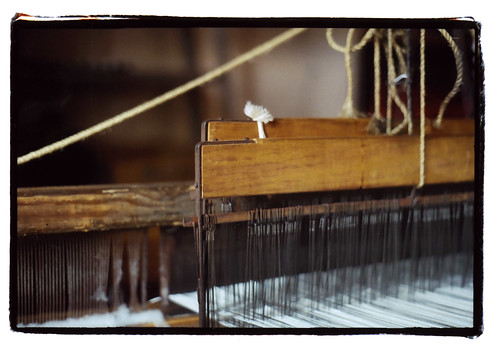
|
check out their new book: Ritmo de Fuego
Ritmo del Fuego / Rhythm of Fire is a unique achievement, telling the story of the deep-seated copperworking tradition of Santa Clara del Cobre, an ancient community in the forested mountains of Michoacán, Mexico. What is often seen as “folk art” is shown to stem from early workshops established in Michoacán during the 8th-9th centuries AD, by coastal traders and artisans from the Andean Region of South America. Since then, the manufactures have included utilitarian and ornamental objects. Many have been recovered at archaeological sites, most notably from the 15th century Tarascan Kingdom. Others embrace forms of Spanish origin after the 16th century conquest. Today in the expanding international market, Santa Clara copperwares include a wide range of sophisticated decorative vases, pitchers, trays, dinner wares and related forms. A vital community has evolved with this ongoing tradition, portrayed with affection and care by the project organizer Michele Feder-Nadoff, and the many other authors in this remarkable, well written contribution to the cultural history of the Americas.
click here to purchase
abidin travels
 (above)Willie Cole, The Difference between Black and White,2005-6. Shoes, wood, metal, screws, and staples, 85 x 16".
(above)Willie Cole, The Difference between Black and White,2005-6. Shoes, wood, metal, screws, and staples, 85 x 16".
ST. LOUIS, MO - War and disaster have profoundly shaped the opening years of the 21st century. In the United States and abroad, acts of violence and terrorism as well as natural catastrophes have resulted in large-scale destruction and displacement affecting the lives of millions. In February, the Mildred Lane Kemper Art Museum at Washington University in St. Louis will present On the Margins, an exhibition exploring the impact of war and disaster through the work of a diverse range of contemporary artists. Curated by Carmon Colangelo — a nationally known printmaker as well as dean of the university's Sam Fox School of Design & Visual Arts — the exhibition will showcase more than a dozen works, ranging from prints and photographs to video and large-scale installations, by ten artists from around the world. Several installations play against traditional approaches to war memorial. For example, Fallen (2004-ongoing), by the American artist Jane Hammond, comprises a large field of brightly colored leaves, each bearing the name of a soldier killed in Iraq. Similarly elegiac is Metal Jacket (1992/2001), by South Korea's Do-Ho Suh, which consists of 3000 dog tags stitched to the liner of a U.S. military jacket. Abidin Travels: Welcome to Baghdad (2006), an interactive video installation by the Iraqi expatriate Adel Abidin, allows viewers to become virtual tourists amidst the wreckage of his native Baghdad.
In conjunction with the exhibition MFA candidates Carianne Noga, Dan Solberg, Erica Millspaugh and I assumed the role of travel agents assisting museum visitors in arranging their virtual flight Baghdad aboard a B52.